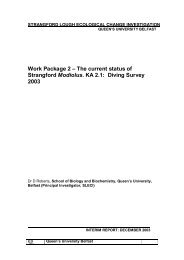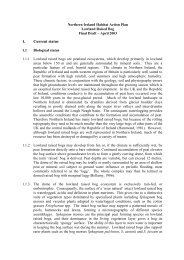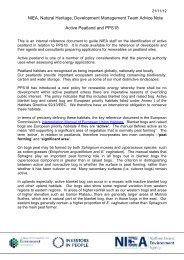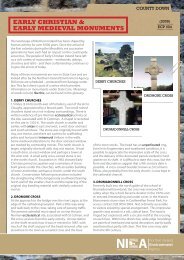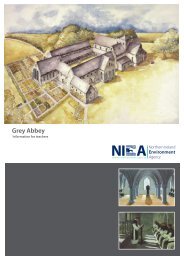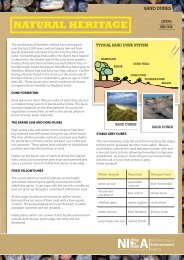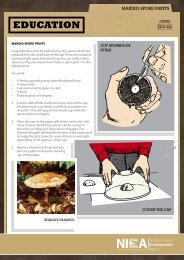TECHNICAL NOTE No. 52 - Cleaning Masonry Buildings ( pdf
TECHNICAL NOTE No. 52 - Cleaning Masonry Buildings ( pdf
TECHNICAL NOTE No. 52 - Cleaning Masonry Buildings ( pdf
You also want an ePaper? Increase the reach of your titles
YUMPU automatically turns print PDFs into web optimized ePapers that Google loves.
<strong>TECHNICAL</strong> <strong>NOTE</strong> <strong>No</strong>. <strong>52</strong><br />
June 1992<br />
Updated January 2006<br />
<strong>Cleaning</strong> <strong>Masonry</strong> <strong>Buildings</strong><br />
(Brick, Stone and External Renders)<br />
Introduction<br />
In most instances the possibilities of cleaning a building are first considered for<br />
aesthetic reasons. If after a proper appraisal of the situation there is any doubt as to<br />
the usefulness of cleaning then the decision should be to leave the building alone.<br />
<strong>Cleaning</strong> of a building can result in hastened decay for newly exposed surfaces and<br />
should only be undertaken after careful consideration.<br />
Before embarking on a contract for cleaning there are a number of questions to be<br />
answered:<br />
i. Does the surface or the pointing need repair?<br />
Most cleaning methods involve water. If excessive amounts are allowed to enter<br />
through fractures or decayed joints it may later be the cause of outbreaks of fungal<br />
decay in embedded timbers and/or the corrosion and expansion of iron cramps and<br />
lintels. These faults must be attended to before any cleaning is attempted;<br />
ii. Know your material. Different repair and cleaning techniques will be appropriate for<br />
different materials. For example, many limestones may benefit from cleaning on a 10-<br />
15 year cycle reducing the build up of harmful crusts. Most sandstones will not derive<br />
much benefit from cleaning and the risks associated may hasten their decay. While<br />
water washing will have little effect removing dirt from sandstones, it can be quite<br />
effective on limestone<br />
iii. What is the nature of the material which is to be removed?<br />
The material may be organic in the form of algae, lichens or mosses or it may be<br />
chemical discoloration and the build up of chemical deposits.<br />
Organic growth is the most common cause of surface discoloration met with in<br />
<strong>No</strong>rthern Ireland. It can be removed by the application of biocides to kill the growth<br />
which is then brushed off dry, followed by the application of a chemical dressing to<br />
inhibit recolonization. Biocides are strictly regulated under Health and Safety<br />
Legislation and their chemical effect on the material of the wall should be carefully<br />
considered before any decision is taken.<br />
Organic growths are not normally damaging to the masonry itself but they do excrete<br />
acids which attack metal work (flashings and lower metal clad roofs) and the matrix of<br />
asbestos cement products.<br />
Where staining and surface salt deposits are the symptom of faults elsewhere following<br />
long term saturation of the masonry, the faults must be first found and corrected.<br />
Deposits of this nature are not usually harmful except in appearance, however deposit
from atmospheric pollution can be a very real and great danger. Thankfully this is rare<br />
in <strong>No</strong>rthern Ireland, but where it does exist it must be removed.<br />
<strong>Cleaning</strong> Methods<br />
Always have a sample panel as a trial carried out and approved before embarking<br />
upon a cleaning scheme. <strong>Cleaning</strong> operatives should be skilled and named for the job.<br />
They should be able to demonstrate this skill as part of the trial as standards can vary<br />
considerably.<br />
The methods available for cleaning chemical deposits are:<br />
(A) Water Washing – This is used principally for limestone or marble. First the<br />
deposits are soaked and softened, then in some techniques loosened by brushing. Do<br />
not use steel wire brushes because the detached wires will be left behind and corrode<br />
causing stains. Bristle, phosphor bronze and brass wire can be acceptable. Finally the<br />
surface is washed down. There are a number of specific techniques from water<br />
sprays, mist sprays, pulse cleaning, water lances and many types of brushes.<br />
The amount of water used must be kept to a practical minimum. Local areas of dirt may<br />
be persistent, in which case a pressure water lance or a different cleaning method may<br />
be used to complete the work. Do not simply continue to saturate the fabric until the dirt<br />
moves. Sometimes on larger schemes, temporary guttering fixed to scaffolding is used<br />
to direct water away from floors below.<br />
(B) Abrasive – this is used principally for sandstones but also for some limestones and<br />
marble. These methods are noisy and create dust or slurry, and may be considered too<br />
great a nuisance. Care is required on the part of the operatives not to over clean,<br />
destroying the surface and detailing. Properly handled, these methods are fast and<br />
effective. Wet abrasive techniques clean with the least damage to the surface. They<br />
use less water than pure washing with water and so reduce the dangers of fungal and<br />
other later decay, but they are more difficult to operate than dry methods and so are<br />
not generally popular with contractors. The size and type of abrasive and the pressure<br />
at which it is applied can vary greatly. Choice should be based upon the hardness of<br />
the masonry and of the dirt to be removed. Sand is the cheapest abrasive but the most<br />
dangerous to health. Copper or Iron Slag, nut shells, glass beads and talc are all used<br />
in different systems. All dry blasting techniques should be followed with a washing<br />
down of the building to remove deposits.<br />
(C) Chemical –<br />
i Alkaline or caustic strippers are only designed to be used on limestones or ceramics.<br />
Their disadvantage is the danger of depositing salts in solution which later discolour<br />
the surface. Their use should be considered only as a last resort. They must be strictly<br />
supervised and staining and damage are common. The advantage is that they do not<br />
attack polished and glazed surfaces.<br />
Ii Acid cleaners are principally used for sandstones and granites. Of the acid cleaners,<br />
hydrofluoric acid either in straight dilution or in combination with other chemicals (as in<br />
Neolith 625ss – Agrément certified) is the only material not to deposit salts in solution<br />
and has been the most popular for this reason over the years. It does however, attack<br />
polishes and glazes and these must be masked. It acts by dissolving the silica binder<br />
which holds dirt onto the surface of sandstones. If the chemical is left on too long the<br />
binder can be deposited as a white mark on the stone which can be very difficult to<br />
remove. Iron deposits in some sandstones can also be mobilised leaving brown<br />
streaks. Other acids such as sodium hydroxide or hydrochloric acid are used but
ecause of the risk of salt mobilisation they have a specific use such as paint or<br />
cement removal or they form part of a proprietary poultice.<br />
Only use a proprietary chemical in cleaning buildings and adhere strictly to the<br />
manufacturer’s instructions. Repeated applications are much better than too long a<br />
dwell time on the stone. Maximum recommended periods are from twenty minutes to<br />
one hour though ten to twelve minutes dwell times can often provide optimum cleaning.<br />
Ensure the area to be cleaned is pre wetted with water to avoid absorption. Application<br />
by brush or spray should be even and planned. The chemical should be thoroughly<br />
washed off at the correct time. Scaffolding should also be thoroughly washed.<br />
It is good practice when using any chemical product on stonework to obtain an analysis<br />
of the masonry. Different chemicals will react differently on different stones. These<br />
effects will be long term and knowledge at the start will help to ensure that an<br />
appropriate decision has been made.<br />
(D) Mechanical – this method includes the use of power tools, scrapers, etc. It is<br />
generally labour intensive and is most suitable for plain flat surfaces rather than detail.<br />
This technique inevitably removes some of the surface and is notoriously difficult to<br />
control. Circular saw marks or depressions often result. The best quality work will be<br />
finished off by hand. Care needs to be taken that removal of the surface will not<br />
accelerate decay.<br />
Post-<strong>Cleaning</strong> Treatment<br />
After cleaning is complete the drains and gulleys must all be checked and left clean<br />
and in working order. Ensure full records are left for further reference.<br />
Further Reading<br />
Ashurst J.,Dimes F.G., Conservation of Building and Decorative Stone, Butterworth<br />
Heinemann, Oxford, 1999.<br />
BS 8221 Stone <strong>Cleaning</strong><br />
TAN9 Stone <strong>Cleaning</strong> Of Granite <strong>Buildings</strong>, Historic Scotland 1997<br />
Stonecleaning in Scotland, Research Summary, Historic Scotland,1992.<br />
TAN18 The treatment of Graffiti on Historic Surfaces, Historic Scotland 1999<br />
TAN 10 Biological Growths on Sandstone <strong>Buildings</strong>: Control and Treatment, Historic<br />
Scotland 1998<br />
Environment and Heritage Service<br />
Built Heritage<br />
Protecting Historic <strong>Buildings</strong><br />
Waterman House<br />
5-33 Hill Street<br />
BELFAST<br />
BT1 2LA<br />
Tel: 028 9054 3145





